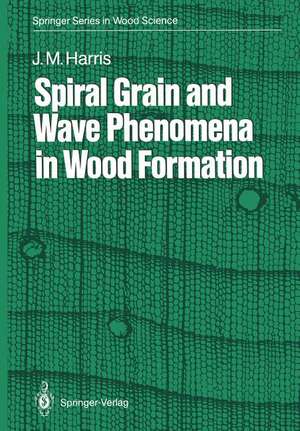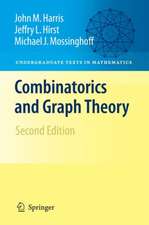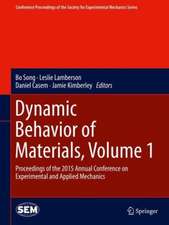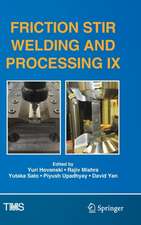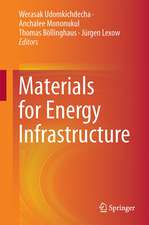Spiral Grain and Wave Phenomena in Wood Formation: Springer Series in Wood Science
Autor John M. Harrisen Limba Engleză Paperback – 10 dec 2011
Din seria Springer Series in Wood Science
- 18%
 Preț: 1543.84 lei
Preț: 1543.84 lei - 23%
 Preț: 2062.76 lei
Preț: 2062.76 lei - 18%
 Preț: 1824.32 lei
Preț: 1824.32 lei - 24%
 Preț: 817.72 lei
Preț: 817.72 lei - 18%
 Preț: 1225.16 lei
Preț: 1225.16 lei - 18%
 Preț: 3288.92 lei
Preț: 3288.92 lei - 18%
 Preț: 948.29 lei
Preț: 948.29 lei - 18%
 Preț: 1222.31 lei
Preț: 1222.31 lei - 18%
 Preț: 2093.60 lei
Preț: 2093.60 lei - 18%
 Preț: 946.87 lei
Preț: 946.87 lei - 15%
 Preț: 643.34 lei
Preț: 643.34 lei - 18%
 Preț: 1122.87 lei
Preț: 1122.87 lei - 18%
 Preț: 1020.30 lei
Preț: 1020.30 lei - 24%
 Preț: 836.42 lei
Preț: 836.42 lei - 20%
 Preț: 569.49 lei
Preț: 569.49 lei - 15%
 Preț: 636.30 lei
Preț: 636.30 lei - 15%
 Preț: 635.31 lei
Preț: 635.31 lei - 18%
 Preț: 878.05 lei
Preț: 878.05 lei - 15%
 Preț: 646.43 lei
Preț: 646.43 lei - 18%
 Preț: 1004.67 lei
Preț: 1004.67 lei - 18%
 Preț: 894.03 lei
Preț: 894.03 lei - 15%
 Preț: 658.70 lei
Preț: 658.70 lei - 15%
 Preț: 641.53 lei
Preț: 641.53 lei - 18%
 Preț: 950.84 lei
Preț: 950.84 lei - 18%
 Preț: 783.35 lei
Preț: 783.35 lei - 15%
 Preț: 645.79 lei
Preț: 645.79 lei - 24%
 Preț: 880.81 lei
Preț: 880.81 lei -
 Preț: 388.13 lei
Preț: 388.13 lei - 18%
 Preț: 780.82 lei
Preț: 780.82 lei - 15%
 Preț: 529.13 lei
Preț: 529.13 lei
Preț: 638.89 lei
Preț vechi: 751.64 lei
-15% Nou
Puncte Express: 958
Preț estimativ în valută:
122.26€ • 128.56$ • 101.02£
122.26€ • 128.56$ • 101.02£
Carte tipărită la comandă
Livrare economică 17 aprilie-01 mai
Preluare comenzi: 021 569.72.76
Specificații
ISBN-13: 9783642737817
ISBN-10: 3642737811
Pagini: 232
Ilustrații: XII, 215 p.
Dimensiuni: 170 x 244 x 12 mm
Greutate: 0.38 kg
Ediția:Softcover reprint of the original 1st ed. 1989
Editura: Springer Berlin, Heidelberg
Colecția Springer
Seria Springer Series in Wood Science
Locul publicării:Berlin, Heidelberg, Germany
ISBN-10: 3642737811
Pagini: 232
Ilustrații: XII, 215 p.
Dimensiuni: 170 x 244 x 12 mm
Greutate: 0.38 kg
Ediția:Softcover reprint of the original 1st ed. 1989
Editura: Springer Berlin, Heidelberg
Colecția Springer
Seria Springer Series in Wood Science
Locul publicării:Berlin, Heidelberg, Germany
Public țintă
ResearchCuprins
1 Defining Spiral Grain.- 1.1 Patterns of Spirality.- 1.2 Interlocked Grain.- 1.3 Wavy Grain.- 1.4 Other Growth Patterns.- 1.5 Conclusions.- 2 Measuring Grain Angle.- 2.1 Detection of Grain Angle.- 2.2 Sampling for Grain Angle.- 2.3 Methods of Measurement and Analysis.- 2.4 Measurement of Interlocked and Wavy Grain.- 2.5 Conclusions.- 3 Effects of Grain Angle on Wood Properties and Uses.- 3.1 Consequences of Anisotropy.- 3.2 Effects on Shrinkage.- 3.3 Effects on Wood Strength.- 3.4 Effect on Other Aspects of Wood Physics.- 3.5 Effect on Conversion, Use and Economics.- 3.6 Effect of Interlocked Grain.- 3.7 Effect of Wavy Grain.- 3.8 Conclusions.- 4 Spiral Grain in Relation to the Environment.- 4.1 Effect of Environmental Variables.- 4.2 Effect of Growth Rate.- 4.3 Balance of Controls.- 4.4 Effects of Silviculture.- 4.5 Advantages for Survival.- 4.6 Conclusions.- 5 Anatomy of Changing Grain Angles.- 5.1 The Role of Cell Structure.- 5.2 Cambium.- 5.3 Morphogenetic Events.- 5.4 Cambial Domains.- 5.5 Wave Aspects of Domain Structure and Function.- 5.6 Anatomy of Slow Changes.- 5.7 Conclusions.- 6 Genetics of Spiral Grain.- 6.1 Basic Requirements.- 6.2 Geographical Variation.- 6.3 Clonal Variation.- 6.4 Sexually Propagated Progeny.- 6.5 Modification of Genotypes.- 6.6 Heritability of Wavy and Interlocked Grain.- 6.7 Strategies for Tree Improvement.- 6.8 Conclusions.- 7 Physiological Aspects of Changing Grain Angles.- 7.1 Requirements.- 7.2 Polarity.- 7.3 The Role of Auxin.- 7.4 Other Factors.- 7.5 Conclusions.- References.
